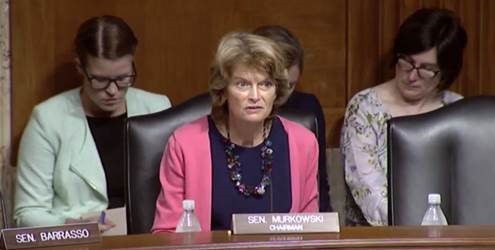Murkowski: Administration’s Proposed Land Use Planning Rule Troublesome For Alaska
Proposed Rule Ignores Voice of State, Local, and Tribal Communities
Washington, D.C. – U.S. Sen. Lisa Murkowski, R-Alaska, delivered the following opening statement at a Senate Energy and Natural Resources Public Lands, Forests and Mining Subcommittee hearing held today to conduct oversight on the Bureau of Land Management’s proposed land use planning rule known as “Planning 2.0.”

Click picture to view video of Murkowski’s opening statement
“As you know, Mr. Chairman, the focus of this hearing is to provide oversight on the BLM’s proposed land use planning rule—“Planning 2.0”—which will make broad changes to how the agency will issue resource management plans moving forward.
For an initiative that claimed to engage state and local governments early in the process, Planning 2.0 is certainly taking a lot of heat right now. The BLM outlines its engagement process online, including a webinar and two public meetings that occurred prior to the development of the proposed rule.
While the agency may feel that they met the FLPMA requirements for outreach, our state governments, especially my colleagues in Alaska, largely disagree. Instead, they have told me that their voices have been ignored, as evidenced by the product BLM noticed in the Federal Register.
BLM is currently obligated to establish management plans that are consistent with state, local, and tribal management practices. Under the proposed rule, the time period for consistency review is limited to 60 days, and the scope is restricted to officially approved and adopted. This is particularly troublesome for my state of Alaska, as the BLM has yet to fulfill Alaska’s entitlement requirements, thus making it impossible for the state to adopt and approve plans for lands it has yet to receive.
As written, the proposed rule makes sweeping changes to both the current resource management planning (RMP) process and the opportunities for public engagement. The drastic changes in the process and the elimination of opportunities for formal public comment, along with the exclusion of several transparency requirements, are alarming to say the least. While BLM attempts to justify many of these changes in the name of streamlining, I am concerned that the long-term result may be a longer process, with state, local, and tribal governments, as well as interested stakeholders, deprived of opportunities to engage in the process in a meaningful way.
In its proposed rule, BLM includes the definition of mitigation “to explain that mitigation includes the sequence of avoiding impacts, minimizing impacts, and compensating for remaining unavoidable impacts. For the first time in a proposed planning regulation, BLM specifically states, “by including this proposed definition in the planning regulations, the BLM acknowledges that this sequence also applies to the planning process.” The emphasis on mitigation, specifically as a means of compensating for “unavoidable impacts” is problematic, as it moves the agency away from its mission of multiple-use.
Finally, I would like to speak to one of the purported primary goals of the proposed rule, which is to “enable the BLM to readily address landscape-scale resource issues.” While I concur with the BLM that the current planning process is far from perfect, I am not convinced that the solution to all present planning issues lie in landscape-scale plans, as we have seen in the sage grouse plan of late. I am particularly concerned about including Alaska in multiple-state plans. While Alaskans certainly love their neighbors in the lower 48, there are certain federal laws that apply only to Alaska that do not apply elsewhere, and specifically cover federal lands. This could prove quite problematic in developing a broad RMP that covered, say, a migratory bird plan for the western United States.
Again, I appreciate you giving me the opportunity to say a few words and I thank you for conducting this very important hearing on these issues.”








